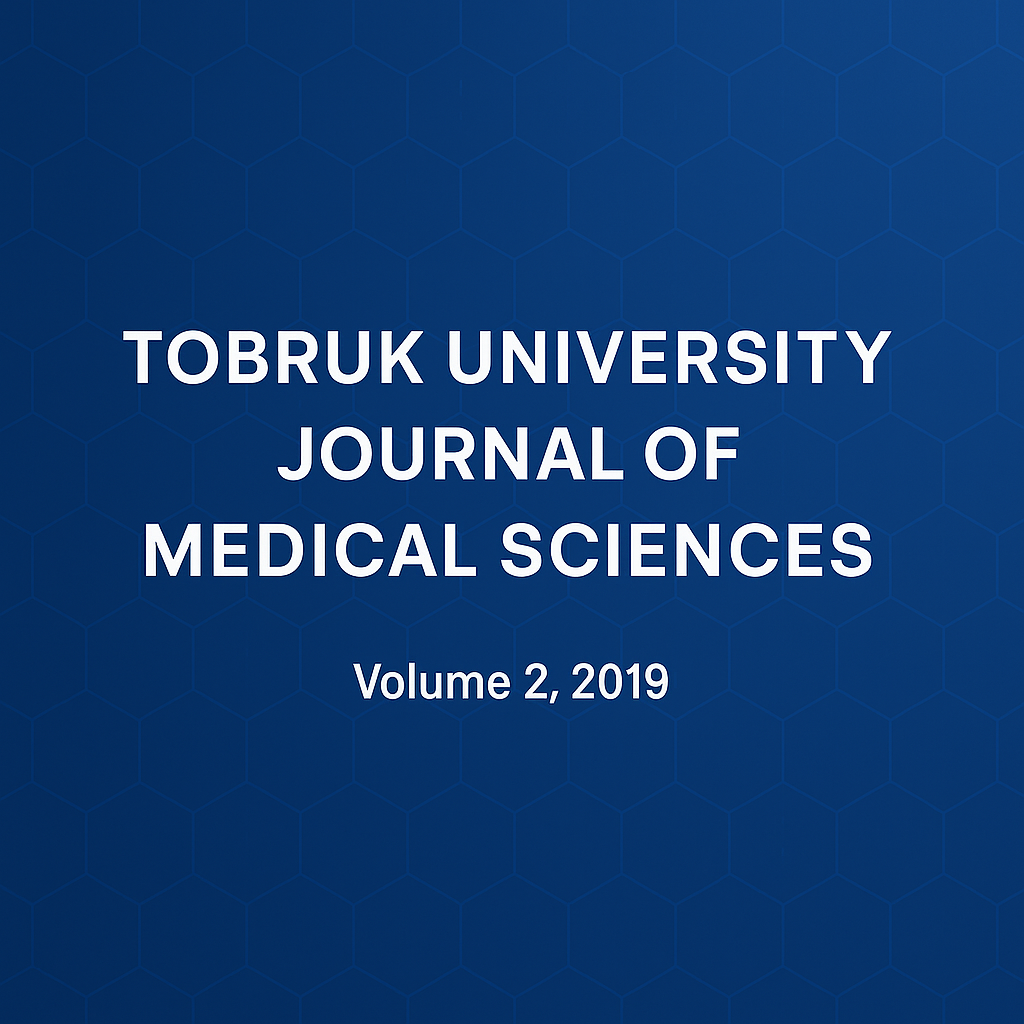Prevalence of HydatidCysts in Herbivorous Animalsand their Relationshipto Humans in Misurata City.
DOI:
https://doi.org/10.64516/smcsbs11Keywords:
Echinococcusgranulosus,, Hydatidosis,, Herbivorous Animals,, Infection,, Prevalence.Abstract
The total number of slaughterers was estimated to be 8462, of which 6420 were camels, 497 were cows and 1545 were sheep in Misurata abattoir. The slaughters were examined for hydatid cysts of Echinococcusgranulosus .The results showed that the number of infected animals was 920 animals, 10.9% of the total number of herbivores slaughtered in Misurata 8462, with the highest infection rate of 672, 73.04% (672/920) in camels, followed by 222 sheep, With a percentage of 14.36% (222/1545), followed by cows with 26, 5.23% (26/497). The results indicated that the highest incidence of hydatid cysts of Echinococcusgranulosusin the liver was sheep (46.7%), followed by camels (45.6%) and cows (7.7%). The results indicated that the highest incidence of Echinococcusgranulosusin the lung was in the camels (84.1%), followed by sheep (14.1%) and cows (1.7%).The Data revealed that the highest incidence of water sacs in the intestines was in sheep by 80% , followed by camel by 20%, while cows had no intestinal infection .The study indicates that the liver is more affected and the vitality of the cysts in the liver were more than those in the lungs, so the liver is an important organ in the continuation of the life cycle of the worm, The liver is considered to be the preferred organ of the Libyan consumer. The infidels tend not to sacrifice the entire infected liver and only the injured part, which is disposed of in an improper manner and often eaten by dogs, is separated, leading to the spread of infection.
References
1 – Abd-Elgader , M.(2006) . Prevalence and morphological studies on the larval cysts of Echinococcusgranulosus in herbivorus animals in Sirt-Libya ; A thesis submitted in partial fulfillment of the requirements for the degree of Master of Science.
2 -Awan , M. A. Q. ; Gusbi , A. M. and Beesley , W. N. (1990) . Echinococosis in Libya .III . Further studies of Echinococcusgranulosus in dogs .Annals of Tropical Medicine and Parasitology ,84 : 473 – 475 .
3 - Bouree , P. (2001) . Hydatidosis : dynamics of transmission . WorldJournal Surgery, 25 (1) : 4 – 9.
4 - Clavel , A.; Varea , M.; Doiz , O.; Lopez , L.; Quilez , J.mCqsti-Ilo , F. J.; Rubio , C. and Gomez-Lus , R. (1999) . Visualization of hydatid elements :comparison of several techniques .JournalClinicalMicrobiology , 37 (5) :1561 – 1563.
5 - Dar , F. K. and Taguri , S. (1978) . Human hydatid disease in Eastern Libya
.Transactions of the Royal Society of Tropical Medicine and Hygiene ,72 :313 – 314 .
6 - Erman , T.; Tuna , M.; Göcer , I.; Ildan , F.; Zeren , M. and Cetinalp, E.
(2001) . Intracranial intraosseous hydatid cysts .NeurosuryFocus ,11 (1) : 1 –3.
7 - FAO (1993) . Zoonotic disease in the Near East Region . Regional Office for the Near East , Cairo .
8 - Gebreel , A. O.; Gilles , H. M. and Prescott , J. E. (1983) . Studies on the sero-epidemiology of endemic diseases in Libya . I. Echinococcosis in Libya. Annals of Tropical Medicine and Parasitology ,77 : 391 – 397 .
9 - Gusbi , A. M. (1987) . Echinococcosis in Libya . I. Prevalence of Echinococcusgranulosus in dogs with particular reference to the role of dog in Libyan society .Annals of Tropical Medicine and Parasitology ,81 (1) : 29 – 34
10 - Gusbi , A. M.; Awan , M. A. Q. and Beesley , W. N. (1987). Prevalence of hydatidosis (Echinococcusgranulosus ) in Sheep.Annals of Tropical Medicine and Parasitology ,81 : 35 – 41 .
11 - Haridy , F. M.; Badaweia , B.; Ibrahem and Tosson , A. M. (2000) . Sheep- dog-man . The risk of zoonotic cycle in hydatidosis .Journal of the Egyptian Society of Parasitology ,30 (2): 423 – 429 .
12 - Ibrahem , M. M. and Craig , P. S. (1998) . Prevalence of cystic echinococcosis in camels (Camelusdromedaries ) in Libya . Journal of Helminthology ,72 : 27 – 31 .
13- Ibrahem , M. M. and Craig , P. S. (1998) . Prevalence of cystic echinococcosis in camels (Camelusdromedaries ) in Libya . Journal of Helminthology ,72 : 27 – 31 .
14- Khan , A. H. and El-Buni , A. A. (1999) . Prevalence of hydatid cystic in slaughtered animals in Benghazi , Libya . Sebha Medical Journal, 2 (1) :7-9 .
15- Khan , A. H. and Kidwai , S. A. (1996) . Management of immunodiagnostic tests in human hydatidosis in Libya .Rivista diParassitologia , XIII : 473 – 477 .
16- Matossian, R. M.; Rickard , M. D. and Smyth , J. D. (1977). Hydatidosis a global problem of increasing importance .Bulletin of the World Organization ,55 : 499 – 507.
17- Mohamed , A. A. ; Fadiel , M. M. and Fateh-Elbab G. A. (2004) . Prevalence and epidemiology of hydatidosis in Local and imported animals SebhaCity .Journal of SebhaUniversity ,vol . 3 (3) : 39 – 51 .
18- Onah , D. N.; Chiejna , S. N. and Emehelu , C. O. (1989) . Epidemiology of echinococcosis / hydatidosis in Anambra state , Nigeria. Annals of Tropical Medicine and Parasitology , 83 (4) : 387 – 393.
19- Rausch , R. L. (1997) . Echinococcusgranulosus : Biology and Ecology. In : Compendium on Cystic Echinococcosis in Africa and In Middle Eastern Countries with Special Reference to Morocco . (eds. F. L. Andersen , H. Ouheli and M. Kachani) . Brigham Young University Provo , Utah , USA .
20- Shambesh , M. K. A. (1997) . Human cystic echinococcosis in North Africa (excluding Morocco) .In : Compendium on Cystic Echinococcosis in Africa and Middle Eastern Countries with Special.
21- Shambesh , M. A.; Craig , P. S., Macpherson , C. N., Rogan , M. T., Gusbi , A. M. and Echtuish , E. F. (1999) . An extensive ultrasound and serologic study to investigate the prevalence of human cystic echinococcosis in northern Libya .Journal of Tropical Medicine and Hygiene, 60 :462- 468 .
22 - Shambesh , M. K.; Macpherson ,C. N. L., Beesley , W. N., Gusbi , A. and Elsonosi , T. (1992) . Prevalence of human hydatid disease in northwestern Libya : a cross-sectional ultrasound study . Annals of Tropical Medicine and Parasitology ,86 : 381 – 386.
23 - Tashani , O. A.; Zhang , L. H., Boufana , B. Jegi , A. and McManus 23- D.
P. (2002) . Epidemiology and strain characteristics ofEchinococcusgranulosus in the Benghazi area of Eastern Libya . Annals of Tropical Medicine and Parasitology ,96 (3) : 1-12.
24- Thompson , R. C. A. and Lymbery , A. J. (1988) . The nature , extent and significance of variation within the genus Echinococcus . Advances in Parasitology ,27 : 209 – 258.
25- Thompson , R. C. A.; Lymbery , A. J. and Constantine , C. C. (1995) . Variation in Echinococcosis : towards a taxonomic revision of the genus . Advances in Parasitology , 35 : 145 – 176.
26- Watson-Jones , D. L.; Criag , P. S.; Badamochir , D.; Rogan , M. T.; Wen , H.; Hind , B. (1997) . A pilot , serological survey for cystic echinococcosis in North-Western Mongolia . Annals of Tropical Medicine and Parasitology , 9 (2) : 173 – 177.












